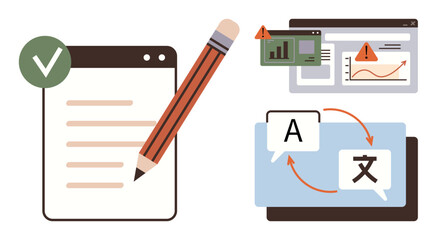Translation breaks down language barriers and allows you to communicate with a global audience. But it’s not just replacing words – quality editing ensures accuracy, clarity, consistency, and cultural appropriateness.
Subject matter expert editors and proofreaders ensure that your translations are free from errors and misunderstandings. They review and correct meaning, style, flow, and consistency, as well as fixing grammatical mistakes.

What is Editing?
Editing is the process of transforming a rough draft into a master piece that effectively communicates your message to your target audience. It involves enhancing clarity, improving structure, ensuring consistency, eliminating errors, and making sure your content is tailored to its intended audience.
There are different types of editing, each with a unique focus. Developmental editing focuses on the structure and content of a document, which is especially helpful for early-stage drafts. Stylistic editing is the process of assessing the tone, style, and phrasing in a document, while copy editing consists of ensuring that the text follows house or other set styles. Proofreading is the final stage of editing and includes checking for grammar, punctuation, and spelling errors.
Getting your writing edited is crucial, especially if it’s important for your business. A professional editor can ensure that your writing is clear, concise, and effective. They can also help you improve your style and tone, so that your work is both professional and appealing to your target audience.
Whether you’re writing an academic paper, a blog post, or an autobiography, it’s important to have your work professionally edited before publishing. A single grammatical error or misplaced punctuation mark can damage the credibility of your work and may cause your audience to lose trust in you. Moreover, it’s often difficult to spot your own mistakes, so it is best to have someone else read through your work and correct any errors that they might find.
Proofreading
A thorough proofreading follows translation to ensure that the final text is accurate and ready for publication. Often referred to as copyediting, this process compares the original and translated documents in order to verify that the message was relayed properly to the target audience and that it is written in a style that meets client specifications and is suited for the language of the target market.
Proofreaders comb through the content page by page, paragraph by paragraph, sentence by sentence, and word by word to scour the text for errors. They look for things like grammatical and spelling errors, formatting issues, word repetition, consistency in tone, syntax, and phrasing, and cultural idioms. While some translation services offer a basic spell and grammar check, it is advisable to find a full-service translation agency that offers both editing and proofreading services in order to guarantee quality and accuracy.
If your business relies on translations to reach new markets and customers, you can’t afford to risk mistakes that will damage the reputation of your brand. A poorly-written and/or mistranslated piece of content could not only confuse your audience but also cause confusion or even legal issues. It is important to hire professional editors and proofreaders who are familiar with your industry in order to spot any cultural nuances that might have been missed by automated tools or even native speakers.
Localization
In a global marketplace, standing out from the competition is critical. Localization allows brands to tailor their message to specific markets by incorporating cultural nuances and preferences that make them feel understood and valued.
Localization requires more than simply translating text; it involves adapting all elements of the content to fit its new audience, including images, color palettes, measurements (e.g., metric versus imperial), emojis (a smiley face that represents happiness in the US and UK may represent contempt or mistrust in China), and layout adjustments for right-to-left languages like Arabic and Hebrew. This customization creates a personalized experience for your audience, which makes them more likely to trust your product or service.
A quality translation and editing service prioritizes localization by ensuring that the work they produce is accurate, effective, and culturally relevant. They also prioritize the use of human linguists over machine translation tools for certain tasks and content that is tied to branding, as the latter can often make mistakes that are unacceptable in business settings.
Additionally, top-tier translation and editing services have a well-designed website and interface, offer free revisions on all assignments, and provide their clients with swift, professional customer support. They should also have a money-back guarantee policy, which shows that they are confident in the quality of their work and are committed to client satisfaction.
Multilingual Customer Support
Offering multilingual customer support allows your customers to connect with your company in their native language. Whether they’re using your website, help center, or social media platforms, providing them with access to the same resources they would have in their home country is essential for a great customer experience.
When you offer multilingual customer support, your team can resolve issues quickly by responding to customers in their language. This gives your customers confidence in your products and service, resulting in higher customer retention. Plus, it gives you more access to their feedback, which can help you refine and grow your product or service.
A well-edited translation is a key component in achieving this goal. By addressing issues of phrasing, clarity, consistency, and cultural appropriateness, editors ensure that the translated text conveys the same meaning as the source.
Finally, by checking for any cultural references or idioms that might not translate well, editors can make sure that the translated text is respectful and sensitive to the local audience. This is important for avoiding any negative repercussions and maintaining brand reputation.
Customers may buy a product for its value, but they stay loyal to a brand that understands them and respects their culture and language. With a multilingual approach to your customer support, you can build these personal connections and cultivate a community of loyal customers around the globe.